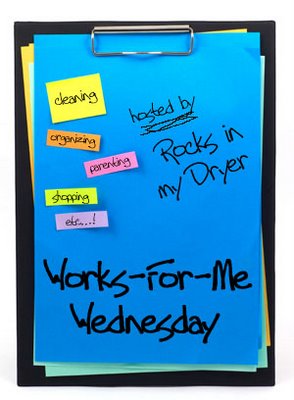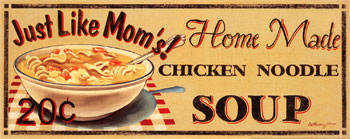How to Save on Food
Wednesday, January 17, 2007

Without Losing Your Mind
Couponing. Price Books. Menus. You've heard it all before. You know you should. You wish you could. But somehow, you just can't make it work.
Here is my system. I've used it for 6 years, so I'd say it works! At least for me!
Buy a plastic 4"x6" index card box. Buy some index cards while you are at it. Get the big one, not the 3"x5" - it's not big enough to use as a coupon organizer. Go ahead and buy it new, retail - you WILL save by shopping! Plus, you need it to be functional, not a cracked or bent hand-me-down. I say plastic because it tends to stay closed better, is durable, and cheaper, but if you like wood, knock yourself out. Get a hair tie (lasts longer than a rubberband) to hold it shut. We're not too proud at Mama's house to flaunt our frugal use of Goody products.

Now, you will be using this to file your coupons, help plan menus, keep track of prices, and prevent disastrous stocking up on bad things.
First, we'll make some divider cards. Get several cards and label them CLEARLY in the upper left hand corner with your coupon categories. For examply, my categories start with Baby (diapers, shampoo, etc. go here). Batteries and Lightbulbs. Car (oil change, tire coupons). Candy (oops... how'd that category get in there?) Just brainstorm what you can. If you need to add something later, you can simply make a new card and insert it - you don't have to worry you'll mess up the pattern.
I file alphabetically, since I shop at many different stores. If you always shop at the same one, you might try filing them aisle by aisle. It's your box, do what works for you.

When you clip coupons, you will place them behind the divider cards. You may find that you have a billion coupons for one type of product. For example, I started with "Hygiene" but had to add cards for Soap, Shampoo, and Shaving as well.
Behind the coupon cards, make some Meat dividers as well (or your staple you base a meal around, for vegans). My box has "Chicken", "Boneless Chicken Breast", Ground Beef, Ground Turkey, Steak (Round, Chuck, etc.) and so on. I also have a "Leftover Bird" card.
Recipes you love, or want to try and clipped out of a magazine, go filed here, behind the appropriate card.
 On the front of your meat card, list the meals you cook most often using those ingredients. My "Ground Turkey" card, for example, has Taco Salad, Meaty Beans and Rice (light beans), Spaghetti Sauce, Lasagna, and so on written on it; my Leftover Bird card has "Divan (cheese, rice, broccoli)" "Soup" , "Tacos", "Enchiladas (corn tortillas, sour cream), "Creamed Chicken (egg noodles)... you know what you cook. The things in parenthesis are special ingredients that are needed. Do this so that when you are at the store and they have a killer markdown on hamburger, you know what you will make with it, and you will buy all of the ingredients right then and there. This way, you don't come home with 10 lbs. of chuck steak and only a vague idea of how you will be consuming it someday.
On the front of your meat card, list the meals you cook most often using those ingredients. My "Ground Turkey" card, for example, has Taco Salad, Meaty Beans and Rice (light beans), Spaghetti Sauce, Lasagna, and so on written on it; my Leftover Bird card has "Divan (cheese, rice, broccoli)" "Soup" , "Tacos", "Enchiladas (corn tortillas, sour cream), "Creamed Chicken (egg noodles)... you know what you cook. The things in parenthesis are special ingredients that are needed. Do this so that when you are at the store and they have a killer markdown on hamburger, you know what you will make with it, and you will buy all of the ingredients right then and there. This way, you don't come home with 10 lbs. of chuck steak and only a vague idea of how you will be consuming it someday.The index cards also serves as my price book. A price book is a notebook or other system where you can keep track of how much things cost. That way, if you see a sale for Cheerios, $1.99 a 16 oz. box (12.4 cents/oz) you can look at your card and see that you only pay 10 cents/oz. for the Malt-O-Meal version at your regular store. No need to stock up on cereal that's actually more expensive. This can really help the impulse buying. Grocery stores know that if they put a product on an endcap and mark it 2/$4, they will sell more of the product than if it's on a regular shelf for $1.99. This helps you outwit them.
For example, I might have a card labelled "Canned Tomatoes". On the front of the card, I would put the store, price, and unit price of my "best finds". Example:
Canned TomatoesNow, notice I list more than one store - if the cheapest store is sold out, but you MUST have the ingredient tonight, you know where to go next. Often, the regular grocery stores will run fantastic sales - usually before Thanksgiving, Easter, a
Crushed
WalMart (Great Value) 28 oz. .96 .08 per oz.
Kroger (DelMonte) 28 oz. 1.19 .0425 per oz.
Best sale 2/99 cents = .0177 per oz. 11/19/06
 nd July 4; often their other sales are on a 6 week cycle. This is so you can be aware of when an item might hit the sale rack next time, and let you know if you should buy 3 cans or 10 cans until that happens. For the newbies, just get in the habit of tracking how much stuff costs you. Then when you spot DelMonte on sale at Big Lots, you'll know whether it's actually a good price or not.
nd July 4; often their other sales are on a 6 week cycle. This is so you can be aware of when an item might hit the sale rack next time, and let you know if you should buy 3 cans or 10 cans until that happens. For the newbies, just get in the habit of tracking how much stuff costs you. Then when you spot DelMonte on sale at Big Lots, you'll know whether it's actually a good price or not.An extra bonus of using these together are stores that double coupon. I've gotten Ragu for free very often, because our Kroger store runs a "Buy one Get one Free sale" every 8 weeks or so. Ragu in a jar costs $1.99 there. So I stockpile my .50 /off Ragu coupons; I buy one, get one free. Usually, you can use one coupon per jar. I give the clerk two .50/off coupons; they double to $2.00 but I only owe the store $1.99. Walgreens often will actually give you the penny back, it's a quirk in their computer system, I think.
Behind the card are my coupons for canned tomatoes. On the back of the card, I would write notes about the product, or what I make most often with it. Example: "Spaghetti sauce - 2 big cans crushed, 1 medium diced.
Pizza sauce - 1 can paste, 1/2 can sauce
and so on.
I also make notes for other things - like on the back of my laundry card - "Husband allergic to Tide." "Cheer smells weird"
Or my 'hygiene card' - "Curad plastic bandaids don't stick. Fabric ones are fine"
Or on the back of the cereal card "Uncle Sam cereal tastes like bird seed"
That way I don't stock up on a sale item that won't work for my family.
Now that you are all organized and ready to be thrifty, let me give you the biggest secret to saving money on food:

Cook from scratch with a menu. And a list.
Aaarrgggghhh.... I just heard the sound of a thousand teeth grinding! It's not that bad, I promise! Use these three steps to plan your week, and start slowly with the scratch cooking. Don't jump in whole hog and decide you will bake your own bread, make your own chicken broth, make noodles from scratch, and only use herbs from your garden (yet to be planted). Learning to cook takes time - do one thing. Start chopping your own vegetables, instead of buying prechopped frozen onions or sliced potatoes in a can. Learn to make a good stock from chicken bones (okay, that ones easy. The most basic is add water. Boil, (Big loud bubbles in the water), then turn down the heat to simmer (small bubbles). Go wild. Add an onion, celery, herbs.
Then master gravy making. Next, stop making mashed potatoes from a box. One thing at a time, Grasshopper, one thing.
You know I have links for you to get you started!
Cook's Thesaurus - anything you wanted to know about food, and substitutions, too.
Robbie's Kitchen - lots of referenc
 e, recipes, and cookery stuff; home remedies too!
e, recipes, and cookery stuff; home remedies too!Saving Dinner Basics - how to cook (a book to buy)
Price Book 101 - in depth article from MommySavers
Okay, back to the menu:
1) Get the grocery ads. I look them up online, actually, most stores post them on the web. Otherwise, mine come in the mail; the Wednesday paper usually has them too, in most towns. Notice what meat is on sale. This is what you will be eating (until you get a good stock going in your freezer. Then you can just eat whatever you want from the freezer, and use the sales to replenish the supply). Also note the loss leaders (when stores sell stuff like milk really cheap to get you in the door) and any produce sales.
Here is a handy tip - SuperWalMart will match any price if you bring in the current grocery ad (must be same brand and size package). So if Bird's Eye is on sale for .99 cents at PigglyWiggly, and Country Crock is on sale for .50 at Safeway, and Walmart toilet paper is the cheapest in the land, just bring your Pig and Safeway ads to Walmart and make one trip!
2) Number a piece of paper from 1-7, or 1-14 if you shop every two weeks. I do this instead of listing the days of the week, because it's faster and plans change sometimes - and it turns out Tuesday wasn't a great night for spaghetti, or it rained all day Saturday making it a good roast day. Gives me some flexibility.
Now, if chicken legs are on sale all over town for 29 cents a pound, then go to your box and
 look at your chicken card. Oh, you could make baked legs, barbecue legs, crockpot garlic and lime legs, chicken and dumplings, fried chicken...
look at your chicken card. Oh, you could make baked legs, barbecue legs, crockpot garlic and lime legs, chicken and dumplings, fried chicken...You have a list of recipes that you know how to make and your family likes. Pick a couple and write them down.
Also pick at least one meal that can be thrown together in 30 min. or less for those days you are feeling sick, running behind, or forgot to take the meat out of the freezer.
Many people also include a leftover night; I don't because my husband dear likes to take leftovers for lunch, and I eat any other leftovers with the kids for my lunches.
Think about sides too. We keep it simple - a vegetable (usually frozen, sometimes canned); a salad (or just 2 different veggies), a starch (rice, noodles, potato). We do brown rice, but it takes forever to cook, not friendly when you are trying to get dinner on the table in 30 minutes or less! So I make the whole bag in a big pot for one meal, put the rest into gallon ziplocks, and freeze it. It takes just as long to make 3 pounds as 1 pound (well, maybe 5 minutes longer)
Don't forget to plan snacks and lunches. We usually eat leftovers, with peanut butter sandwiches rounding it out. At least write down a couple of ideas - so you have a plan when the morning slipped away from you and all of the sudden it's noon and you haven't a clue! You can plan specific snacks for specific days, or I just make a list of snack ideas. It might be helpful to have a list of breakfast ideas, too.
3) Take your grocery ads and menu and make your list. Your cards will tell you if you need something specific to make a recipe. If your feeling creative, peek at the recipes you clipped from Good Housekeeping (neatly filed and accessible now) and plan to make one of those.
Still too hard? Try the book, Saving Dinner by Leanne Ely. It contains weekly menus, with recipes, and she does the grocery list for you. Also, she is a dietician, and they are healthy; all but the crockpot meals cook up in about 30 minutes, the menus are arranged by season (so you can eat fresh, seasonal veggies). You will not be 'shopping the sales' with this book, but you will still save money because you will buy food that you have a plan to eat.
You just need a couple of more things and you are DONE!
Put these in your box as well:
A card labeled "Gifts" - for when you see the perfect thing for husband or daughter, but their birthday is 6 months away. Some people write down clothing sizes, etc., too.
A small calculator (fill in your price book while you are at the store. You don't have to actually buy the food to note the price!)
A pair of kid sized scissors (get the pointy kind. Now you will always have scissors for your coupon clipping.)
A pen. Maybe two if you are like me and can't ever keep one. (Cross off your list as you go, make note of new products, write your prices down)
Store cards You know, the ones that you sign up for to get discounts. Everybody but the Big Blue W has one. Yes, I know they make keychain ones, but sometimes I am shopping without my keys (with someone else, drove husband's car, or whatever). Besides, my purse has enough stuff floating around in it, what with the matchbox cars, crayon stumps, and wadded up Kleenex - no need to add a pile of plastic too.
A small notebook (for your grocery list and menu plan, of course!) or just use the index cards. Don't forget to put it on your fridge or in your household notebook when you are done - don't toss your menu!
Now, take the money you've saved and send it to
Mama Says
PO Box 123
Or, keep it for yourself.
Happy shopping!
Tags: Nutrition, Works for Me Wednesday, Crafts and Cookery
Labels: Frugal, homemaking, Works For Me Wednesday
posted by Milehimama @ Mama Says at 1/17/2007 08:26:00 AM | Permalink |
|








